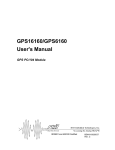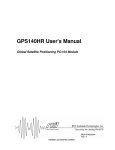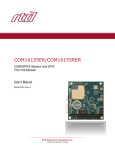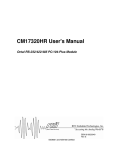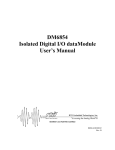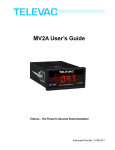Download GPS6185HR User`s Manual - RTD Embedded Technologies, Inc.
Transcript
GPS6185HR User's Manual Global Satellite Positioning PC/104 Module BDM-610020042 Rev. C ISO9001 and AS9100 Certified GPS6185HR User's Manual RTD EMBEDDED TECHNOLOGIES, INC. 103 Innovation Blvd State College, PA 16803-0906 Phone: +1-814-234-8087 FAX: +1-814-234-5218 E-mail [email protected] [email protected] Web Site http://www.rtd.com Page 2 of 35 Manual Revision History Rev A New manual Rev B Added DIO description, GPS installation and IDAN info Rev C Added JP10 and JP11 Published by: RTD Embedded Technologies, Inc. 103 Innovation Boulevard State College, PA 16803 Copyright 2005 by RTD Embedded Technologies, Inc. All rights reserved The RTD Embedded Technologies Logo is a registered trademark of RTD Embedded Technologies. dspModule, cpuModule, and utilityModule are trademarks of RTD Embedded Technologies. PC/104, PC/104-Plus, and PCI-104 are registered trademarks of the PC/104 Consortium. All other trademarks appearing in this document are the property of their respective owners. Page 3 of 35 Table of Contents Introduction ...................................................................................................................................... 7 Product Overview......................................................................................................................... 7 Board Features ............................................................................................................................ 7 GPS6185HR Features.......................................................................................................... 7 GPS Receiver ....................................................................................................................... 7 I/O Interfaces................................................................................................................................ 8 16C550 Compatible UARTs ................................................................................................. 8 Connector Description .......................................................................................................... 8 Available Options ......................................................................................................................... 8 Getting Technical Support ........................................................................................................... 8 Board Connections ........................................................................................................................ 10 Connector and Jumper Locations.............................................................................................. 10 External I/O Connections ........................................................................................................... 10 CN3 – Digital Input/Output Connector.................................................................................... 11 CN7 – GPS Receiver Connector (to GPS module)................................................................ 12 CN5 – GPS Utility Connector ................................................................................................. 13 CN6 – Serial Connector ......................................................................................................... 14 CN4 – USB Connector ........................................................................................................... 15 Jumpers ..................................................................................................................................... 16 GPS or COM Base Address Jumpers (Default: GPS = 3E8h, COM = 2E8h)....................... 16 IRQ Jumpers (Default: GPS IRQ 5 closed, G Jumper closed) ......................................... 18 (Default: COM IRQ 10 closed, G Jumper closed) ................................................................. 18 Reserved IRQs ................................................................................................................... 18 The G Jumper..................................................................................................................... 19 RS-422/485 Termination for CN6 (Default: JP3 open) .......................................................... 19 JP3 Jumper – Default Open ............................................................................................... 19 GPS Configuration (Default: JP8 1-2 = closed, JP8 3-4 closed) .......................................... 19 JP8 & JP10 Jumpers – Default JP8 1-2, JP10 1-2............................................................. 20 JP9 Jumper – Default 1-2 ................................................................................................... 20 Page 4 of 35 DIO Pullup/Pulldown Configuration (Default: JP1 & JP2 2-3 = closed) ................................ 20 JP1 Jumper – Default 2-3 ................................................................................................... 20 JP2 Jumper – Default 2-3 ................................................................................................... 20 Active Antenna Supply ........................................................................................................... 20 Board Installation ........................................................................................................................... 21 Installing the Hardware .............................................................................................................. 21 Static Precautions .................................................................................................................. 21 Steps for Installing.................................................................................................................. 21 Configuring Software ................................................................................................................. 22 Hardware Description .................................................................................................................... 23 Overview .................................................................................................................................... 23 Block Diagram............................................................................................................................ 23 The NovAtel GPS Receiver Modules......................................................................................... 24 Antenna...................................................................................................................................... 24 UARTs........................................................................................................................................ 24 USB............................................................................................................................................ 24 Pulse Outputs............................................................................................................................. 25 1 pulse/sec output and LED ................................................................................................... 25 Software Programming.................................................................................................................. 26 Device I/O Map .......................................................................................................................... 26 GPS6185 Control/Status............................................................................................................ 26 GPS6185 Digital I/O................................................................................................................... 27 GPS6185 RTD ID ...................................................................................................................... 28 Interrupts .................................................................................................................................... 29 GPS6185HR Specifications........................................................................................................... 30 GPS Receiver Specifications ..................................................................................................... 30 Physical Attributes.................................................................................................................. 30 Operational ............................................................................................................................. 30 RF Signal Environment .......................................................................................................... 30 Environmental ........................................................................................................................ 30 Page 5 of 35 UARTs........................................................................................................................................ 30 GPS6185HR Operating Conditions ........................................................................................... 31 Additional Information.................................................................................................................... 32 NovAtel OEM4-G2L GPS Receiver ........................................................................................... 32 NMEA-0183 v2.01 Standard ...................................................................................................... 32 Serial Port Programming............................................................................................................ 32 Interrupt Programming ............................................................................................................... 32 GPS Antennas ........................................................................................................................... 32 Appendix A .................................................................................................................................... 33 IDAN module Installation and Configuration.............................................................................. 33 Installing NovAtel Module .......................................................................................................... 33 Limited Warranty............................................................................................................................ 35 Page 6 of 35 Introduction Product Overview The GPS6185HR is designed to provide a global positioning system (GPS) for PC/104-based systems. Included on the GPS6185HR is a NovAtel OEM4-G2L series GPS receiver. The GPS6185HR has an onboard dual UART chip that permits communication with both serial ports on the GPS receiver module over the PC/104 bus without using other serial ports in the PC/104 system. The GPS6185HR supports NAVMAN binary protocol and National Marine Electronics Association (NMEA-0183) v2.01 messages. Board Features GPS6185HR Features o o o Two direct connections to onboard GPS receiver module Choice of GPS message formats RTCA RTCM RTCMV3 CMR NMEA PC/104 compliant GPS Receiver TM The OEM4-G2L is a parallel 24-channel, dual-frequency or 12-channel, single-frequency receiver featuring a 60 mm x 100 mm form-factor and low power consumption. All OEM4G2L cards feature position output, real-time DGPS positioning, support for RTCA and RTCM messages, two serial ports and a USB interface. The OEM4-G2L is configurable as a rover or base station and is designed for embedded applications. All OEM4 family receivers have the following features: • 24 channel “all-in-view” parallel tracking • Pulse Aperture Correlator (PAC) technology • Fast reacquisition • Fully field-upgradeable firmware • Low power consumption • 20 Hz raw data and position output rates At a minimum, the following models are available for each receiver: • L1 only • L1/L2 • L1 plus RT-20 • L1/L2 plus RT-2 • L1 plus Satellite-Based Augmentation System (SBAS) support • L1/L2 plus SBAS support Those models with dual-frequency capabilities make the following possible: • Longer baselines in differential positioning mode, due to the reduction errors • Faster resolution of carrier-phase ambiguities when performing RTK • Enhanced positioning precision due to the additional measurements Page 7 of 35 I/O Interfaces The GPS6185HR can be controlled and monitored by software through the two dedicated serial ports of the module. A utility I/O connector provides a connection to the onboard GPS 1 pulse/sec time mark as well as programmable onboard timing signals. Two event inputs can be used to trigger position of time logs. 16C550 Compatible UARTs The GPS receiver module communicates through two dedicated UART channels allowing other serial ports in the system to be free for the user. The 16C550 UART is recognized by all x86 operating systems, and does not require a special communication driver to receive data from the GPS receiver. The base address and interrupt of the UART channel can be changed with onboard jumpers. For information on how to install the jumpers, please refer to the “Board Connections” chapter of this manual. Connector Description The GPS receiver antenna interface and external clock interface are female MMCX type miniature coaxial connectors. Connect your antenna directly to the GPS6185HR antenna connector, or use a short cable inside your enclosure to connect to a feed through connector to allow connection of the antenna to the wall of your enclosure. The GPS module supplies up to 100 mA of 4.75 – 5.10 VDC for antenna LNA. All other I/O connections to the GPS6185HR use 0.1” header type terminals. Available Options The GPS6185HR is available as a starter kit, bundled with an active antenna. It may also be purchased as an IDAN module for integration into an RTD IDAN system. The following is a summary of the different GPS6185 configurations: Part Number Description GPS6185HR GPS6185HR SK-GPS6185HR GPS6185HR with an active antenna IDAN-GPS6185HRS GPS6185HR mounted in an IDAN frame IDAN-SK-GPS6185HRS GPS6185HR mounted in an IDAN frame with an active antenna For antenna specifications, please refer to the “Additional Information” chapter of this manual. Getting Technical Support If you are having problems with your system, please try the following troubleshooting steps: Page 8 of 35 • Simplify the System – Remove modules one at a time from your system to see if there is a specific module that is causing a problem. • Swap Components – Try replacing parts in the system one-at-a-time with similar parts to determine if a part is faulty or if a type of part is configured incorrectly. If problems persist, or you have questions about configuring this product, obtain the base address and IRQ settings of the GPS6185HR and other modules in the system. After you have this information, contact RTD Embedded Technologies via the following methods: Phone: +1-814-234-8087 E-Mail: [email protected] Be sure to check the RTD web site (http://www.rtd.com) frequently for product updates, including newer versions of the board manual and application software. Page 9 of 35 Board Connections Connector and Jumper Locations The following diagram shows the location of all connectors and jumpers on the GPS6185HR. Future revisions of the GPS6185HR may have cosmetic differences. For a description of each jumper and connector, refer to the following sections. GPS6185HR Connector and Jumper Locations Base Address Jumpers GPS/ COM IRQ Jumpers and G Jumper GPS/ COM JP3 JP8 JP1 & JP2 DIO Pullup/Pulldown CN6 Serial Port JP9 CN5 GPS Utility JP11 GPS Antenna Input (On GPS Module) JP10 CN4 USB GPS External Clock Input (On GPS Module) CN3 Digital I/O PC/104 (ISA) Connector External I/O Connections The following sections describe the external I/O connections of the GPS6185HR. Page 10 of 35 CN3 – Digital Input/Output Connector The GPS6185 offers 16 bit-programmable digital I/O lines. These can be pulled high or pulled low through 10K Ohm resistors using JP2 to control bits DIO0 – DIO7 and JP1 to control bits DIO8 - DIO15. Pin 1 2 3 4 5 6 7 8 9 10 11 12 13 14 15 16 17 18 19 20 Name GND DIO0 DIO1 DIO2 DIO3 DIO4 DIO5 DIO6 DIO7 +5 VDC GND DIO8 DIO9 DIO10 DIO11 DIO12 DIO13 DIO14 DIO15 +5 VDC Description Ground Digital Input/Output Bit 0 Digital Input/Output Bit 1 Digital Input/Output Bit 2 Digital Input/Output Bit 3 Digital Input/Output Bit 4 Digital Input/Output Bit 5 Digital Input/Output Bit 6 Digital Input/Output Bit 7 +5 Volts DC Ground Digital Input/Output Bit 8 Digital Input/Output Bit 9 Digital Input/Output Bit 10 Digital Input/Output Bit 11 Digital Input/Output Bit 12 Digital Input/Output Bit 13 Digital Input/Output Bit 14 Digital Input/Output Bit 15 +5 Volts DC Page 11 of 35 CN7 – GPS Receiver Connector (to GPS module) The GPS receiver module connects to the 2mm female socket connector. The table below shows the pin connections of the GPS receiver interface to the GPS6185HR. Pin 1 2 3 4 5 6 7 8 9 10 11 12 13 14 15 16 17 18 19 20 21 22 23 24 Name GND GND VARF PPS VCC VCC Event 2 Event 1 ERROR PV CTS2 Reset RTS2 RXD2 CTS1 TXD2 RTS1 RXD1 Reserved TXD1 USB DUSB D+ GND GND Description Ground Ground Variable Frequency Out 1 Pulse Per Second +3.3V Supply +3.3V Supply Mark 2 Input Mark 1 Input Fatal error when high Valid GPS position when high COM 2 Clear to send Low indicates GPS in reset COM 2 Request to send COM 2 Received data COM 1 Clear to send COM 2 Transmitted data COM 1 Request to send COM 1 Received data Reserved COM 1 Transmitted data USB data USB data Ground Ground Page 12 of 35 CN5 – GPS Utility Connector The GPS module has several discrete inputs and outputs that are accessed through CN5. The connections to CN5 are either direct to the Novatel module or buffered through the EPLD. JP11 1-2 selects buffered through the EPLD and is the default setting. Use JP11 2-3 if you can not tolerate the 7.5 nanoseconds of delay on these signals. The pin connections are shown below. Pin 1 2 3 4 5 6 7 8 9 10 Name PPS VARF Event 1 Event 2 Reset Reserved PV ERROR GND GND I/O Output Output Input Input Output Output Output Description 1 Pulse Per Second Output Variable Frequency Output Mark 1 Input Mark 2 Input Low indicates GPS is in reset Reserved, do not connect High output indicates Valid GPS Position High output indicates GPS Fatal Error Ground Ground Page 13 of 35 CN6 – Serial Connector GPS COM2 can be directed to either the on-board UART or this serial connector. Pin 1 2 3 4 5 6 7 8 9 10 RS-232 Name DCD DSR RxD RTS RS-232 Description Carrier Detect Data Set Ready Receive Data Request To Send RS-422 Name RxDTxD+ RS-422 Description Reserved Reserved Receive Data (-) Transmit Data (+) TxD Transmit Data TxD- Transmit Data (-) CTS Clear To Send RxD+ Receive Data (+) DTR RI GND GND Data Terminal Ready Ring Indicator Ground Ground GND GND Reserved Reserved Ground Ground Note on using RS-422 or RS-485 Mode When using the serial port in RS-422 or RS-485 mode, the serial transmitters are enabled and disabled under software control. The transmitters are enabled by manipulating the Request To Send (RTS*) signal of the first serial port controller. This signal is controlled by writing bit 1 of the Modem Control Register (MCR) as follows: • • If MCR bit 1 = 1, then RTS* = 0, and serial transmitters are disabled If MCR bit 1 = 0, then RTS* = 1, and serial transmitters are enabled For more information on the serial port registers, including the MCR, please refer to a standard PC-AT hardware reference for the 16550-type UART. Page 14 of 35 CN4 – USB Connector GPS can be connected to a CPU USB port. The NovAtel module will appear as three COM ports to the system. Pin 1 Name Vcc 2 3 4 5 6 7 8 9 10 n/c Dn/c D+ n/c GND GND Shield Shield Description USB Power Input (Does not power NovAtel Receiver) No connect USB Data No connect USB Data + No connect No connect No connect Shield Shield Page 15 of 35 Jumpers The following sections describe the jumper configuration options available on the GPS6185HR. For a reference that shows the location of each set of jumpers, refer to the diagram of the GPS6185HR at the beginning of this chapter. The default factory jumper settings are listed in the following table: Jumper Description GPS Base Address Jumpers COM Base Address Jumpers GPS IRQ Jumpers COM IRQ Jumpers GPS Configuration Jumper JP8 GPS Configuration Jumper JP9 GPS Configuration Jumper JP10 GPS Configuration Jumper JP11 DIO Pullup/Pulldown JP1 and JP2 RS-422/485 Termination JP3 Default Factory Setting Set to 3E8h (COM3:) Set to 2E8h (COM4:) IRQ 5 and G jumper closed IRQ 10 and G jumper closed 1-2, GPS COM2 to second UART 1-2, PC compatible baud clock 1-2, CN6 serial port disabled 1-2, CN5 signals buffered Pulldown Open, no termination GPS or COM Base Address Jumpers (Default: GPS = 3E8h, COM = 2E8h) The base address selection jumpers (A3 through A8) allow you to set the base address of the first UART that connects to the GPS module COM1 and the second UART that connects to the GPS COM2. Any software that accesses the board will do so through reads and writes to the I/O address set by the jumpers. To function properly, the I/O address the software is expecting must match the base address set by the jumpers. As shown in the figure below, A3 is located at the left end of the jumper block, while A8 is located at the right end: The table on the following pages shows the possible base address settings for the GPS6185HR. All base addresses are in hexadecimal. An ‘X’ indicates a closed jumper, while an empty cell indicates an open jumper. Base Address (Hexadecimal) 200 208 210 218 220 228 A8 A7 Jumpers A6 A5 A4 A3 X X X X X Page 16 of 35 X X 230 238 240 248 250 258 260 268 270 278 280 288 290 298 2A0 2A8 2B0 2B8 2C0 2C8 2D0 2D8 2E0 2E8 2F0 2F8 300 308 310 318 320 328 330 338 340 348 350 358 360 368 370 378 380 388 390 398 3A0 3A8 3B0 3B8 3C0 3C8 3D0 3D8 X X X X X X X X X X X X X X X X X X X X X X X X X X X X X X X X X X X X X X X X X X X X X X X X X X X X X X X X X X X X X X X X X X X X X X X X X X X X X X X X X X X X X X X X X X X X X X X X X X X X X X X X X X X X X X X X X X X X X X X X X X X X X X X X X X X X X X X X X X X X X X X X X X X X X X X X X X X X Page 17 of 35 X X X X X X X X X 3E0 3E8 3F0 3F8 X X X X X X X X X X X X X X X X X X X X By default, the GPS6185HR comes configured with a base address of 0x3E8 for the first UART which connects to GPS COM1 and 0x2E8 for the second UARD that connects to GPS COM2. When selecting a base address for the GPS6185HR, please observe the following guidelines: • Every device in your PC/104 system must have a unique base address! When selecting a base address for the GPS6185HR, make certain that it does not conflict with any other devices. • Base addresses 0x3F8 and 0x2F8 are typically used by serial ports COM1 and COM2, respectively. If you wish to use one of those base addresses, you will need to disable any conflicting serial port. • Some operating systems expect UART devices to be located at the standard serial port base addresses (0x3F8, 0x2F8, 0x3E8, and 0x2E8). Setting your GPS6185HR to one of these addresses can make system setup and configuration easier. IRQ Jumpers (Default: GPS IRQ 5 closed, G Jumper closed) (Default: COM IRQ 10 closed, G Jumper closed) The IRQ selection jumpers allow you to set the IRQ used by the serial port UART of the GPS6185HR. The GPS6185HR can be configured for any one of the following IRQs: 2, 3, 4, 5, 6, 7, 10, 11, 12, 14, or 15. The IRQ can be set by closing the appropriately labeled jumper on the board. The IRQ jumpers are located next to base address jumpers, as shown in the diagram at the beginning of this chapter. Note: Typically IRQs can not be shared; although there are some special cases (see “The G Jumper” later in this document). In general, the IRQ you select should not be used by any other devices in your system. Reserved IRQs Some of the IRQ choices on the GPS6185HR may already be used by your CPU’s onboard peripherals. Some commonly-used IRQs are: • IRQ 2/9 is used by some VGA controllers. Page 18 of 35 • IRQ 3 or 4 may be set to a serial port in your system. You may need to disable a serial port in your system prevent an IRQ conflict. • IRQ 5 or 7 may be used by the CPU’s parallel port. Check your CPU’s configuration to avoid a conflict. • IRQ 12 is used by the PS/2 mouse. To use this IRQ, you will need to remove the PS/2 mouse from the system. Some CPUs also require a BIOS setting to disable the PS/2 mouse controller. • IRQ 14 is used by the primary IDE controller. To use this IRQ, you will need to disable the primary IDE controller. • IRQ 15 is used by the secondary IDE controller. To use this IRQ, you will need to disable the secondary IDE controller. The G Jumper The GPS6185HR supports shared interrupts as defined by the PC/104 specification. This sharing is accomplished via the G jumper, which is located adjacent to the IRQ jumpers. The G jumper installs a 1K-ohm resistor to pull the signal to the low state, allowing an interrupt to drive the signal high. To share interrupts, configure the devices for the same IRQ, and close the G jumper on one (and only one) of the devices. When using interrupt sharing, consider the following guidelines: • An interrupt can only be shared if all devices on the IRQ support it. If you have two sharing and one non-sharing device on the same IRQ, it will not work. • To share interrupts, the system’s drivers and operating system must support it. The Interrupt Service routines must be written to check all devices on an IRQ when the interrupt is detected. Many popular operating systems do not support interrupt sharing for ISA devices. Note: If you are not sharing interrupts, make sure you leave the GPS6185HR’s G jumper closed! RS-422/485 Termination for CN6 (Default: JP3 open) JP3 Jumper – Default Open If JP3 is closed, the RS-422/485 serial port on CN6 is terminated with 120 ohms. This should only be used in RS-422/485 mode. If jumper JP8 3-4 is open, then jumper JP3 must be open. GPS Configuration The jumper blocks JP8 and JP10 are used to configure the mode of operation of the GPS receiver module. The location of jumpers JP8 and JP10 can also be found in the diagram at the beginning of this chapter. Page 19 of 35 JP8 & JP10 Jumpers – Default JP8 1-2, JP10 1-2 JP8 1-2 and JP10 1-2 (Default setting) This setting enables the board’s second UART and connects it to the Novatel GPS module’s COM2:. JP8 1-2 and JP10 2-3 This setting connects the board’s second UART to CN6 providing a standard serial port for the computer. The Novatel module’s COM2 is not used in this configuration. JP8 2-3 (JP10 in either position) This setting disables the board’s second UART and connects the Novatel GPS module’s COM2 to the serial connector CN6. In this setting the 1PPS signal can use the second UART’s interrupt to generate a 1PPS interrupt. JP9 Jumper – Default 1-2 1-2 selects normal baud clock. The UART clock for both UARTS is set to the PC standard 1.8432 MHz. The highest baud rate possible is 115.2K baud. 2-3 selects high speed baud clock. This 14.7456 MHz UART clock will enable high speed baud clocks. The highest baud rate possible is 921.6K baud. With this setting, baud rate divisors will be 8 times larger for the same baud rate. For example, in normal mode 9600 baud has a baud rate divisor of 12. In high speed mode 9600 baud has a baud rate divisor of 12 * 8 = 96. DIO Pullup/Pulldown Configuration (Default: JP1 & JP2 2-3 = closed) JP1 Jumper – Default 2-3 2-3 closed selects a 10 Kohm pulldown on digital I/O DIO8 – DIO15. 1-2 closed selects a 10 Kohm pullup on digital I/O DIO9 – DIO16. JP2 Jumper – Default 2-3 2-3 closed selects a 10 Kohm pulldown on digital I/O DIO1 – DIO8. 1-2 closed selects a 10 Kohm pullup on digital I/O DIO1 – DIO8. Active Antenna Supply The antenna connector supplies up to 100 ma of 4.75 - 5.10 volts for active GPS antennas. Page 20 of 35 Board Installation Installing the Hardware The GPS6185HR can be installed into a PC/104 or PC/104-Plus stack. It can be located almost anywhere in the stack, above or below the CPU. Note: If the GPS6185HR is installed in a PC/104-Plus system, be sure to not break the chain of PCI devices (such as stacking the GPS6185HR between two PC/104-Plus boards). Static Precautions Keep your board in its antistatic bag until you are ready to install it into your system! When removing it from the bag, hold the board at the edges, and do not touch the components or connectors. Handle the board in an antistatic environment, and use a grounded workbench for testing and handling of your hardware. Steps for Installing 1. Shut down the PC/104 system and unplug the power cord. 2. Ground yourself with an anti-static strap. 3. Set the Base Address and IRQ jumpers as described in the previous chapter. 4. Steps 4 through 7 are only necessary if you have purchased the GPS61885HR without the module. Refer to Appendix A for IDAN connector configuration. 5. Line up the pins of the NovAtel module you have purchased with the GPS6185HR’s socket connector and gently press the module onto the board. Do not attempt to force the module onto the board, as this can lead to bent/broken pins. 6. Install the screws that are shipped with the board to secure the module to the carrier board. 7. Attach the external antenna to the MMCX connector. 8. Attach the external clock input MMCX connector. 9. Line up the pins of the GPS6185HR’s PC/104 connector with the PC/104 bus of the stack and gently press the board onto the stack. The board should slide into the matching PC/104 connector easily. Do not attempt to force the board, as this can lead to bent/broken pins. If any boards are to be stacked above the GPS6185HR, install them. 10. Attach any necessary cables to the PC/104 stack. 11. Re-connect the power cord and apply power to the stack. 12. If the system has a PCI bus, enter the BIOS setup and reserve the GPS6185HR’s IRQ as a Legacy ISA resource. 13. Apply power to the system, and verify that all of the hardware is working properly. Once power is applied, the GPS receiver will automatically initialize. Page 21 of 35 Configuring Software The GPS6185HR uses a standard serial port UART for host communication. Therefore, you must “install” a serial port under your host operating system for the GPS6185HR to be recognized. If the GPS6185HR was installed using a standard serial port base address (0x3F8, 0x2F8, 0x3E8, or 0x2E8), your operating system may detect the GPS6185HR’s UART automatically. If the GPS6185HR was not auto-detected, or if it was configured with a non-standard base address, the serial port will need to be configured manually. Beyond the IRQ and base address, you may also need to configure the serial port parameters. The UART interface is controlled by jumper settings. The procedure for configuring the serial port will vary depending on the operating system. Consult the operating system’s documentation for instructions on how to do this. Page 22 of 35 Hardware Description Overview This chapter describes the major hardware building blocks of the GPS6185HR. The components discussed in this chapter include: • The GPS Receiver Module • Antenna • UART Channel • Pulse Outputs Block Diagram Below is a block diagram of the GPS6185HR. I S A B U S 16C550 UART 1 COM1 COM2 16C550 UART 2 NovAtel OEM4-G2L GPS Engine Utility Mux Controlled by JP8 and JP10 USB CN4 JP11 2-3 GPS Utility CN5 JP11 1-2 RS-232/422/485 CN6 JP9 1-2 JP9 2-3 Digital I/O CN3 Divide by 8 14.7456 MHz EPLD Page 23 of 35 The NovAtel GPS Receiver Modules TM The GPS6185 supports all NovAtel OEM4-G2L GPS Receiver Modules. The OEM4-G2L is a parallel 24-channel, dual-frequency or 12-channel, single-frequency receiver featuring a 60 mm x 100 mm form-factor and low power consumption. All OEM4-G2L cards feature position output, real-time DGPS positioning, support for RTCA and RTCM messages, two serial ports and a USB interface. The OEM4-G2L is configurable as a rover or base station and is designed for embedded applications. Communication to and from the receiver is performed through one or two serial channels that are connected to onboard UARTs. The receiver’s primary serial port outputs navigation data and accepts commands from the OEM application is always connected to the first UART on the GPS6185. The secondary serial port on the GPS module can be directed to either the second UART channel or to a connector to interface with external devices. This manual is not intended to be a GPS handbook. For more information on the GPS receiver module please refer to the chapter titled ”Additional Information”. Antenna An active antenna is required because its low-noise amplifier (LNA) boosts the power of the incoming signal to compensate for the line loss between the antenna and the receiver. NovAtel offers a variety of single and dual-frequency GPS antenna models. All include band-pass filtering and an LNA. The GPS antenna you choose will depend on your particular application. UARTs GPS data is sent to the host from the receiver through standard 16C550 compatible UARTs. All x86 operating systems will recognize and support this serial communication device. The GPS6185HR uses its own onboard serial port and will not reserve serial port resources from the system. The I/O base address and interrupt for this serial port can be flexibly set as described in previous chapters of this manual. After setting the base address and IRQ, you can use any communication software package or terminal program to connect to your GPS6185HR UART. The oscillator frequency is 1.8432 MHz (default) or 14.7456 MHz. A reference for programming serial port UARTs can be found in the chapter titled “Additional Information” at the end of this manual. Only TXD, RXD, CTS and RTS lines of the UART are connected to the GPS receiver. The DTR signal of the first UART is used to generate a GPS reset signal. A reset pulse will be generated when the DTR signal transitions from asserted to de-asserted (MCR bit 0 transitions from 1 to 0). USB The OEM4-G2L receivers running firmware version 2.100 or higher, along with the accompanying NovAtel USB drivers for Windows 2000 and Windows XP, provide three virtual serial ports over a single USB connection using USB D(+) and USB D(-) signals. These three virtual serial ports, identified by the GPSCard as USB1, USB2, and USB3, are available to existing Windows applications which use COM ports to communicate (for example, HyperTerminal and GPSolution4). The NovAtel USB drivers assign COM port numbers sequentially following any Page 24 of 35 existing ports on the PC. For example, if a PC has COM1 and COM2 ports, the NovAtel USB drivers will assign COM3 to USB1, COM4 to USB2, and COM5 to USB3. The assignment of COM port numbers is tied to the USB port on the PC. This allows you to switch receivers without Windows assigning new COM ports. However, if you connect the receiver to a different USB port, Windows detects the receiver's presence on that USB port and assigns three new COM port numbers. The NovAtel USB Configuration Utility installed with the NovAtel USB drivers allows you to change the COM port numbers assigned to the virtual serial ports. The USB drivers, along with installation instructions, are available on the OEM4 Family CD by selecting USB Support from the main menu. You can also check for updates to the drivers or release notes on NovAtel’s website at www.novatel.com. Pulse Outputs 1 pulse/sec output The GPS receiver on the GPS6185HR generates a 1 pulse/sec buffered TTL level output that is synchronized with the Coordinated Universal Time (UTC) second. The rising edge of this signal is synchronized with the UTC within 50 ns. The receiver software produces a data message containing the UTC time associated with each time mark pulse. This signal is available on CN5. Page 25 of 35 Software Programming Device I/O Map The GPS6185HR is an I/O mapped device. The each serial port GPS6185HR occupies eight bytes of host PC I/O space. This window is freely selectable by the user as defined by the base address jumper settings. After setting the base address the user has access to the internal resources of the GPS6185HR control logic. These resources are not described in detail, since they are mapped as a standard PC serial port. A reference for programming serial port UARTs can be found in the chapter titled “Additional Information” at the end of this manual. The I/O map of the GPS6185HR is shown in below. As shown, the module occupies two blocks of eight addresses. The Base Address (designated as BA) can be set using the jumpers as described in Chapter 2 (Board settings). The following sections describe the register contents of each address used in the I/O map. GPS6185HR I/O Map Write GPS COM1 DTR is used to reset the GPS GPS COM2 N/A N/A N/A GPS Control Set Digital Outputs 1-8 Set Digital Outputs 9-16 Set Direction Bits 1-8 Set Direction Bits 9-16 Read Address GPS COM1 GPS BA + 0h GPS BA + 7h COM BA + 0h COM BA + 7h GPS BA + 400h GPS BA + 401h GPS BA + 402h GPS BA + 403h GPS BA + 404h GPS BA + 405h GPS BA + 406h GPS BA + 407h GPS COM2 Read RTD ID data Read RTD ID data Reset RTD ID Pointer GPS Status Digital I/O 1-8 Digital I/O 9-16 Read Direction Bits 1-8 Read Direction Bits 9-16 GPS BA = Base Address of GPS UART COM BA = Base Address of COM UART (Jumper selected to GPS COM2) GPS6185 Control/Status GPS BA + 403h Control/Status (Write/Read, 8-bit) Write Bit 0 Serial Port CN6 Protocol 0 = RS-232 1 = RS-422/485 Page 26 of 35 Bit 1 Serial Connector Source (JP8 must be in 1-2, JP10 also performs this function) 0 = Novatel (default) 1 = UART B Bit 2 1 PPS Interrupt Enable (JP8 must be off) 0 = Disable (default) 1 = Enable Bits 7 - 3 Reserved (write as 0) Value after reset is 00h Read Bit 0 Serial Port CN6 Protocol 0 = RS-232 1 = RS-422/485 Bit 1 Reserved (read as 0) Bit 2 GPS Reset Status 0 = GPS in reset 1 = GPS normal Bit 3 GPS Position Valid 0 = GPS not ready 1 = GPS position valid Bit 4 GPS Error 0 = GPS normal 1 = GPS error Bit 5 Event 1 0 = Event 1 input is low 1 = Event 1 input is high Bit 6 Event 2 0 = Event 2 input is low 1 = Event 2 input is high Bit 7 GPS 1 Pulse per second 1 pulse per second from GPS GPS6185 Digital I/O GPS BA + 404h Digital I/O 1-8 (Write/Read, 8-bit) This register controls the output bits 1 - 8. The last data written to the port or the input data, depending on the state of the direction bit in register BA + 406h, can be read by reading BA + 404h. GPS BA + 405h Digital I/O 9-16 (Write/Read, 8-bit) Page 27 of 35 This register controls the output bits 9 - 16. The last data written to the port or the input data, depending on the state of the direction bit in register BA + 407h, can be read by reading BA + 405h. GPS BA + 406h Direction (Write/Read, 8-bit) This register controls the direction of I/O bits 1 - 8. A 1 written to a bit will set that bit to an output, a 0 will set the bit to an input. At reset all bits are set to inputs. JP2 can be used to add either a 10K Ohm pullup or pulldown to the I/O pins. GPS BA + 407h Direction (Write/Read, 8-bit) This register controls the direction of I/O bits 9 - 16. A 1 written to a bit will set that bit to an output, a 0 will set the bit to an input. At reset all bits are set to inputs. JP1 can be used to add either a 10K Ohm pullup or pulldown to the I/O pins. GPS6185 RTD ID GPS BA + 400h - BA + 401h RTD ID (Read only, 8-bit or 16-bit) RTD ID is a method to identify a board on the ISA bus. There are two 8-bit registers mapped at 400h and 401h above the board base address. The registers can be read as two 8-bit or one 16-bit. An internal pointer is autoincremented with every read to either address so the data read will step through the table below. The pointer is set to zero at reset. GPS BA + 402h RTD ID Reset Pointer (Read only, 8-bit only) A read to BA + 402 will set a pointer that determines what data will be read when you read BA + 400h and BA + 401h. The pointer is set to zero at reset. Index Data 8-bit read 16-bit read 0 1 2 3 4 5 6-9 Device ID 85h 61h 35h 14h Revision LSD Revision MSD Ignore 6185h RTD Vendor ID EPLD Revision Reserved Page 28 of 35 1435h Revision Ignore 10 11 12 13 14 15 16 17 18 - 255 Board name string Unused G P S 6 1 8 5 <nul> FFh GP S6 18 5<nul> FFFFh Interrupts Interrupts are used to notify the host CPU that an event happened on a particular device. In general, interrupts are more efficient than a polling technique, where the CPU must query the device status at regular intervals. Devices that use interrupts have a special connection to the CPU, called an interrupt request line (IRQ). When the device needs the CPUs attention, it asserts the IRQ line. Once the interrupt has been processed, the IRQ line is de-asserted. The GPS6185HR uses jumper-selected interrupts for both UARTs. However, it will not actually generate interrupts unless the Interrupt Enable register has been properly programmed. Since the GPS6185HR has 16C550 UARTs, it supports all of the standard serial port interrupt events. These events include: • Received data available • Transmit buffer empty • Line Status Register change • Modem Status Register change A detailed explanation of serial port interrupts is beyond the scope of this manual. For more information, consult a serial port programming reference. The chapter titled “Additional Information” lists some resources to help the user. Note: When the UART clock is running at a higher frequency, transmit/receive interrupts will happen more frequently. Many operating systems can not process interrupts quickly enough to handle this load. When developing your software, be sure to consider the operating system’s limitations. Page 29 of 35 GPS6185HR Specifications GPS Receiver Specifications Physical Attributes o o o Size: 3.6”L x 3.8”W x 0.6”H (90mm L x 96mm W x 15mm H) Weight: 0.24bs (0.10 Kg) Power Consumption: 2W @ 5 VDC Typical Operational GPS receiver Novatel OEM4-G2L series Time to first fix Hot 30 seconds, warm 40 seconds, cold 50 seconds Update rate 20 Hz Reacquisition 0.5 seconds L1 typical 1 second L2 typical Dynamics Vibration Velocity Height Supported data protocols 4G sustained tracking 515 m/s2 18,288 m RTCA, RTCM, RTCMV3. CMR and NMEA GPS6185 board power requirement +5V RF Signal Environment Antenna Connector MMCX female connector External Clock Input Connector MMCX female connector Environmental Cooling Convection Operating temperature -40º to +85ºC Humidity RH up to 95% non-condensing UARTs Number 2 Page 30 of 35 UART compatibility 16C550 Oscillator frequency 1.8432 MHz or 14.7456 MHz jumper selectable Base addresses 64 each Interrupts 2, 3, 4, 5, 6, 7, 10, 11, 12, 14 and 15 GPS6185HR Operating Conditions Operating temperature range -40º to +85ºC Storage temperature range -55o C to +125o C Humidity RH up to 95% non-condensing Page 31 of 35 Additional Information NovAtel OEM4-G2L GPS Receiver For a downloadable datasheet for the Novatel GPS receiver visit the receiver manufacturer’s website: http://www.novatel.com/ NMEA-0183 v2.01 Standard For a complete description on the National Marine Electronics Association (NMEA-0183) v2.01 protocol visit the NMEA website: http://www.nmea.org/ Serial Port Programming For more information about programming serial port UARTs, consult the following book: Serial Communications Developer’s Guide By Mark Nielson ISBN: 0764545701 Interrupt Programming For more information about interrupts and writing interrupt service routines, refer to the following book: Interrupt-Driven PC System Design By Joseph McGivern ISBN: 0929392507 GPS Antennas Novatel offers a varity of GPS antennas suitable for these receivers on thier website: http://www.novatel.com/ Page 32 of 35 Appendix A IDAN module Installation and Configuration The following section describes how to connect a Novatel GPS module in the IDAN frame and make the necessary connections to the IDAN cables. IDAN-GPS6185HRS Connection Locations: Bottom View Ribbon Cables disconnected for viewing Serial Port USB Digital I/O GPS Utility GPS Antenna Input On Module GPS Antenna SMA Input PC/104 (ISA) Connector GPS External Clock Input On Module GPS External Clock SMA Input Installing NovAtel Module All cables possible will be connected to the module. You will have to remove the Digital I/O connection to get access to the RF connectors located on the NovAtel Module. Refer to page ten of this manual for board connector locations. Do not force connectors as this may damage the connectors. Install the two MMCX conectors to the poper positions and reinstall the Digital I/O connector. Place the IDAN frame in the IDAN stack and connect the antenna for proper operation. Page 33 of 35 IDAN-GPS6185HRS Connection Locations: TopView PC/104 (ISA) Connector GPS Antenna SMA Input GPS External Clock SMA Input Digital I/O GPS Utility Serial Port USB 6 mounting standoffs with screws are included to secure the module to the carrier board Page 34 of 35 Limited Warranty RTD Embedded Technologies, Inc. warrants the hardware and software products it manufactures and produces to be free from defects in materials and workmanship for one year following the date of shipment from RTD EMBEDDED TECHNOLOGIES, INC. This warranty is limited to the original purchaser of product and is not transferable. During the one year warranty period, RTD EMBEDDED TECHNOLOGIES will repair or replace, at its option, any defective products or parts at no additional charge, provided that the product is returned, shipping prepaid, to RTD EMBEDDED TECHNOLOGIES. All replaced parts and products become the property of RTD EMBEDDED TECHNOLOGIES. Before returning any product for repair, customers are required to contact the factory for an RMA number. THIS LIMITED WARRANTY DOES NOT EXTEND TO ANY PRODUCTS WHICH HAVE BEEN DAMAGED AS A RESULT OF ACCIDENT, MISUSE, ABUSE (such as: use of incorrect input voltages, improper or insufficient ventilation, failure to follow the operating instructions that are provided by RTD EMBEDDED TECHNOLOGIES, "acts of God" or other contingencies beyond the control of RTD EMBEDDED TECHNOLOGIES), OR AS A RESULT OF SERVICE OR MODIFICATION BY ANYONE OTHER THAN RTD EMBEDDED TECHNOLOGIES. EXCEPT AS EXPRESSLY SET FORTH ABOVE, NO OTHER WARRANTIES ARE EXPRESSED OR IMPLIED, INCLUDING, BUT NOT LIMITED TO, ANY IMPLIED WARRANTIES OF MERCHANTABILITY AND FITNESS FOR A PARTICULAR PURPOSE, AND RTD EMBEDDED TECHNOLOGIES EXPRESSLY DISCLAIMS ALL WARRANTIES NOT STATED HEREIN. ALL IMPLIED WARRANTIES, INCLUDING IMPLIED WARRANTIES FOR MECHANTABILITY AND FITNESS FOR A PARTICULAR PURPOSE, ARE LIMITED TO THE DURATION OF THIS WARRANTY. IN THE EVENT THE PRODUCT IS NOT FREE FROM DEFECTS AS WARRANTED ABOVE, THE PURCHASER'S SOLE REMEDY SHALL BE REPAIR OR REPLACEMENT AS PROVIDED ABOVE. UNDER NO CIRCUMSTANCES WILL RTD EMBEDDED TECHNOLOGIES BE LIABLE TO THE PURCHASER OR ANY USER FOR ANY DAMAGES, INCLUDING ANY INCIDENTAL OR CONSEQUENTIAL DAMAGES, EXPENSES, LOST PROFITS, LOST SAVINGS, OR OTHER DAMAGES ARISING OUT OF THE USE OR INABILITY TO USE THE PRODUCT. SOME STATES DO NOT ALLOW THE EXCLUSION OR LIMITATION OF INCIDENTAL OR CONSEQUENTIAL DAMAGES FOR CONSUMER PRODUCTS AND SOME STATES DO NOT ALLOW LIMITATIONS ON HOW LONG AN IMPLIED WARRANTY LASTS, SO THE ABOVE LIMITATIONS OR EXCLUSIONS MAY NOT APPLY TO YOU. THIS WARRANTY GIVES YOU SPECIFIC LEGAL RIGHTS, AND YOU MAY ALSO HAVE OTHER RIGHTS WHICH VARY FROM STATE TO STATE. Page 35 of 35




































